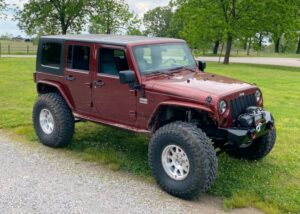
Jeep Wranglers have become more of a statement than a utility vehicle in the last 15 years or so, with many of them just having an ungodly amount of stupid accessories bolted on to make them stand out from all of the other yuppy Jeep owners. So having a Rubicon kind of sets me up to be lumped in with some of those owners, who have more money than mechanical smarts. But I’ve been a Jeep guy since I turned 16, and started out with the original yuppy Jeep according to die-hard Jeepers – a 1987 YJ. They’ve only gotten more refined since then, and I have to admit that when I bought this 2008 JK I kind of felt guilty because that’s what all the soccer moms and guys having midlife crisis’s bought. But now that the JL is out, the JK can be appreciated a bit more for what it is beyond the nice interior and V6 engine – it’s still a very capable rig, in stock form. I have taken bone stock JK rental Jeeps places that no sane person would go, and have never gotten into a situation that the Jeep couldn’t get out of. I’ve had my doubts of course, but these Jeeps always find traction and go if you give them the opportunity.


My JKUR Wrangler has a lot of upgrades, but the coolest one is the 5.7 Hemi swap. Sure, it’s lifted and on 40″ tires, it has a ton of aftermarket parts, the suspension is pretty dialed in, but nothing gets more attention than the fact that I have a V8 engine under the hood. Everyone appreciates horsepower, not everyone understands proper suspension geometry and steering upgrades, having lockers and regeared axles, or a 4:1 low transfer case. Hemi JKs have been around for a while, but most of them are owned by people with enough money to pay a shop to use an aftermarket kit that basically takes all of the challenge out of the swap. Anybody with enough money can go to a dealership and have a Hemi swapped into their Jeep, but not many have figured out how to do it on their own. That may be the biggest surprise when I’m telling someone about my Hemi Jeep – they are shocked that this is a DIY swap and it’s totally integrated into the factory electronics. The gauges all work, there aren’t any check engine lights or weird stuff, cruise control still works, and it even looks somewhat factory under the hood. Here are some details on how we did it.
First, this swap would not have happened if it wasn’t for my friend and right-hand man Ryan, he is the one who sold me the Jeep WK and he did basically all of the work along with Justin, and helping hands from Shawn and Tripp as needed. Shawn geared the axles to 5.38:1, so not only does the Jeep have a 330hp / 375 lb.ft torque motor in it, but it’s also geared really low. Those power numbers are slightly higher now after custom tuning, a really free-flowing exhaust, huge air intake, and larger throttle body. It will throw you back in the seat and it does spin both 40″ tires a little bit without having to power brake it. It’s got some serious balls for a big Jeep on 40’s.


So the swap details… the engine is from a 2005 WK, we also used the 545RFE transmission from the Jeep. I had to buy a transfer case adapter to mate the transmission to the 241J Rubicon transfer case, and had to buy some random parts to convert the Jeep body from a manual transmission to an automatic – they use a different console, different plates and brackets under the console, of course I had to get the shifter. There was also a 2-wire harness that I had to wire in from the main firewall plug to the fuse box, this harness was supplied by Hotwire Auto. That’s where I got the full harness and they made it work for my swap. They also provided an unlocked ECM from an 07/08 Ram 2500, which is how we got the 2005 motor to talk to the 2008 body control module (BCM). Jeep didn’t switch to CANBUS until 2006, so the Jeeps prior to that year are still OBDII and won’t communicate with the BCM. They are totally different BUS systems, that’s how the data gets moved from one point to another.
The first step was removing the engine and transmission from the WK. This took a couple of days, which was really like 4 or 5 hours of solid work. We never get to work on something straight through, it always comes in spurts when we have spare time in the shop or when Ryan wants to stay after work and get stuff done. I think if we had all of the parts here and did nothing but this swap, it could be done in a few days start to finish. Lets call it a week. I know some people say the AEV swaps can be done in a weekend, and they probably can if you work quickly. We fabricated our own engine mounts, transmission crossmember mount, and had to figure out a lot of this as we went. So it ended up taking us about 2.5 months, which includes waiting 4 weeks for the harness and 3 weeks for the transmission adapter. Removing an engine is always easier than putting one in, especially if you do it like we do. The front end and fenders come off, everything gets unbolted, fluids spill everywhere, and it gets lifted out with a forklift. We weren’t concerned about hurting the WK, it probably won’t ever get another motor put in so it’s basically just a parts vehicle now.

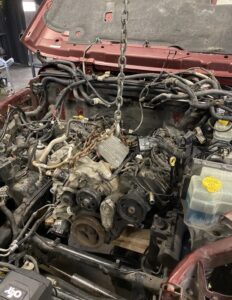
Once the engine and transmission were out, we cleaned them up, inspected everything for damage. There was a rat’s nest inside the air box so we wanted to make sure nothing got in past the throttle body. A couple of coil packs got damaged and we replaced those. Otherwise it was all good, no issues. That drivetrain was placed very gently on the sop floor and then the 3.8 V6 and 6 speed transmission came out of the JK. We were more careful this time, but that 3.8 is so small it really came out pretty easily. I had thought about swapping it into the WK but it’s so tiny that it might make a really good go kart motor, I haven’t made up my mind yet what we’ll do with it. It ran great, just not enough power for the 40’s. When the Jeep had stock tires on it, the 3.8 would roast them in 2nd gear no problem, it was surprisingly fast. Everyone says they are turds but I really had no complaints until the bigger tires went on. Anyway, the 3.8 was removed and then we were able to test fit the 5.7 Hemi. This was kind of tricky because we never unbolted the transmission from the engine, so guiding the whole assembly into the engine compartment took some time and all four of us were pushing and pulling on it. Once it finally went in, it fit like a glove. Since we were making our own engine mounts, we were able to put the engine where we wanted it to go – not where everyone else does it. The reason for this is we didn’t want to do all of the relocation BS that goes along with the DIY kits – there is a several page parts list of OEM shit you have to buy to make the 5.7 fit in a JK, and you have to relocated the steering shaft, oil filter, clearance the AC compressor, clearance the firewall, move the battery, and some other stuff. What did we do to get around all of that? We moved the motor about 1″ to the passenger side. It’s offset in the engine compartment and you’d never be able to tell by looking at it. The driveshafts line up, linkages line up, no issues at all. We also set the engine down lower in the compartment to keep the center of gravity low and not have to deal with the firewall. And finally, we moved the engine as far forward as possible which gave us the oil filter clearance – no adapter needed. The battery is still in the stock location and orientation, the steering box has plenty of room next to the AC compressor, the steering shaft has plenty of room to spin, it’s just a perfect fit.
Once the engine and transmission were mocked up, we were able to make the engine mounts and transmission mount and get them bolted into place. But that meant they had to be pulled back out, so once everything was marked and brackets were test-fit, the Hemi came out again. Engine mounts were welded to the frame, and we’re actually using the factory Hemi mounts on the block. Our brackets just bolt to those motor mounts. The transmission mount was finished after the Hemi went back in, plus we were waiting on the transfer case adapter to come in and it ended up taking several weeks for it to show up. You need the adapter and a seal. When those came in, we were able to bolt up the transfer case and driveshafts again, and then getting all of the engine accessories was the next move.

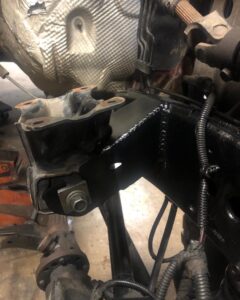
The radiator we used is a specific one for this swap, it’s available from Summit. It fits the JK body but has enough cooling capacity for the Hemi. We’re using the JK electric fan and a Painless Wiring standalone fan controller because the factory one was kind of weird. I think it would have worked eventually but we had a couple of close calls with engine temps and the Painless setup is less than $100, it’s basically bulletproof. We have a shiny overflow bottle mounted where the factory plastic bottle went, and we had to get some new radiator hoses and modify one of the stock ones to work. But that was all relatively easy.

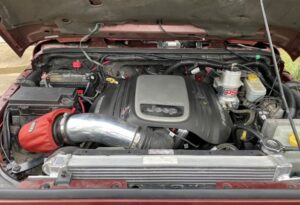
The air intake is custom made from some random parts I got on Summit. We basically bought a bunch of different tubes and elbows and just made it work. It is really simple and works great. If the throttle body was any closer to the radiator, the 90 degree elbow on the air intake would contact the fan shroud. You can literally fit one piece of paper between them, but not two. Two pieces will not clear. It doesn’t get any tighter than that.

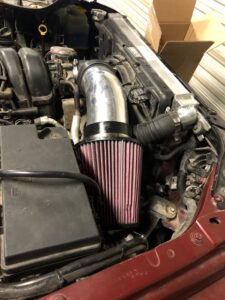
Moving on, we put a new PSC steering pump and remote reservoir on because the steering needed some extra power and I’ll probably end up doing hydro assist before long, although the Jeep does turn fine even at an idle. But it won’t if the tires ever get wedged up against a rock or something. The PSC kit includes a bracket and tells you where to mount the can, so that was all easy. We added a power steering cooler up front next to the transmission cooler.

Hooking up fuel is pretty simple, you just need a couple of adapters to bolt onto the Hemi fuel rail and then you can use the factory lines from the donor vehicle (Hemi lines are bigger than the JK fuel lines). Better yet, we just bought a fuel line kit and ran all new from the tank up. It wasn’t very much money and it looks cool.
I think it was at this point I had decided that I didn’t really want to make the factory Hemi harness work, originally I had planned on wiring it up myself using an 06 WK ECM. I’m notorious for taking years to finish a project, I just have too many things going on all the time to focus on one thing. And as it turns out, the WK ECM wouldn’t have worked as is, I would have had to get someone to disable the security. I knew it had to be programmed to my BCM VIN number but I didn’t know there was a security system built in that disables the starter relay if things don’t match up. So this is when I spent a little money and bought the full harness and ECM from Hotwire Auto down in Mena Arkansas, about 5 hours south of us. Chris was awesome to work with and really helped out with some tech support issues after we got the harness in that were not his fault. They make all kinds of standalone harnesses, so check them out if you need something. They even have a standalone for the 3.8 V6 so that might come in handy if I do something else with the old motor. If I ever get to build my Viper buggy, I’ll get a Viper harness from them too.
While we were waiting for the harness to be made and shipped up to us, we just tinkered with some odds and ends. New headlights, turn signal lights, fog lights, brake lights, a new heater core and front speakers, replaced the headlight multi function switch because it was glitchy, and probably some other stuff I’m forgetting. We just fixed what we could while waiting.

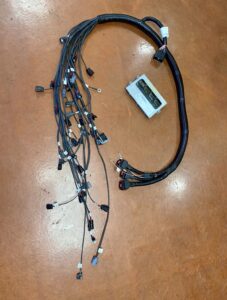
When the harness came in, Ryan had it all plugged in before I could even finish the email I was working on. It must have been 10 to 15 minutes, and he’s not a wiring guy. The only five things we had to wire ourselves were three wires that go into an ECM connector, and the two wires that plug in for the manual to auto conversion. Everything is labeled so you know exactly where it goes, and all of the wires are the exact correct length to be routed like factory wiring. It looks really clean. After we wired it up and double checked everything, we turned the key to see what would happen – the moment of truth. The starter engaged, but the Jeep didn’t start. That’s always a bummer. It turned out the fuel lines we ran got mixed up somehow, I didn’t really pay attention to this part of it much, but something was hooked up as a return line when it didn’t need to be. Once that was fixed, it fired right up and idled smoothly. With open headers, it’s louder than hell but sounds really cool at an idle.

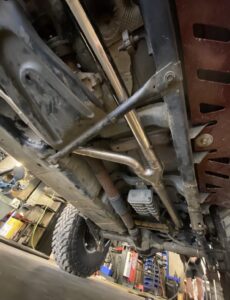
Once we knew it would start, we had to finish up the exhaust and transmission/transfer case linkages. The exhaust is all custom, we ordered a couple of universal parts kits and one Y pipe and made it all work. It looks really good. The exhaust is 2.5″ stainless pipe coming off of the flanges, and it converges into a Y pipe around the middle of the front door. Then it’s all 3″ exhaust from there back to a Magnaflow stainless muffler mounted in the stock location. Originally it had a Flowmaster 50 series which sounded awesome at an idle, but sounded like it had rocks in it when the Jeep first started and idled high, and when it would shift while driving. It was annoying. We tried a resonator behind the Y pipe first and it helped, but not enough. So the Magnaflow went on and it sounds great now. It’s very quiet at an idle, you almost can’t hear it running if you are 10-15 feet away and there are other noises outside. But when you get on it, it screams. In a good way. The cold start high idle sounds pretty good too. Since the Jeep is off road only, we are not using catalytic converters which meant we had to use o2 sensor foolers on the downstream sensors. They are just little spark plug foulers that are modified to let more exhaust flow into them, but by spacing the sensors away from the full flow of the exhaust it gives the downstream sensors a cleaner reading and doesn’t throw any codes.

After all of this was done, the only check engine light I had was an emissions one – it was from the EGR not being hooked up. Again, off road use only, I don’t want that shit recirculating back into the engine, so we deleted the EGR and got rid of the charcoal box under the Jeep. But how would we get rid of the check engine light? With a Diablo Trinity T2 and custom tunes by Hemifever, that’s how. The Jeep didn’t really need any more power but the tunes Hemifever provided made it run a lot better, like noticeably better. It went from not being able to spin the tires, to spinning them pretty easily. We also put a Fastman 82mm throttle body on to get a little more air flow. Air in, air out, extra fuel. That’s all it needs. And a throttle booster to get rid of the pedal lag.


So that’s it, a DIY Hemi swap as simple as possible. I can’t say everyone can do it because most people don’t have fabrication tools or skills, but if you can make some motor mounts and a new transmission crossmember mount, you can probably pull this off on your own. I saved several thousand dollars compared to a DIY kit, and $15k-$20k compared to having a shop do this for me. Cost effective Hemi swaps are possible, you just need to know where to get your stuff.
Leave a Reply